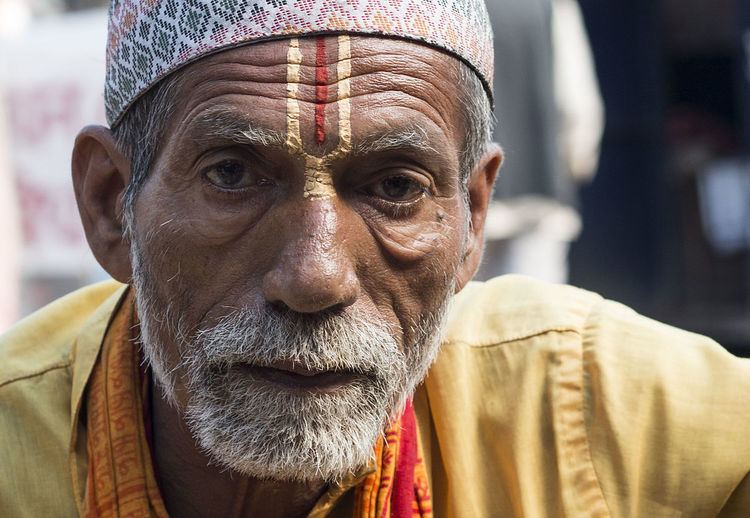 | ||
In Hinduism, the tilaka (Hindi: तिलक) is a mark worn usually on the forehead, sometimes other parts of the body such as neck, hand or chest. Tilaka may be worn on a daily basis or for rites of passage or special religious occasions only, depending on regional customs.
Contents
The term also refers to the South Asian ritual of marking someone's forehead with a fragrant paste, such as of sandalwood or vermilion, as a welcome and expression of honor when they arrive.
Description
The tilaka is a mark created by the application of powder or paste on the forehead. Tilakas are vertical markings worn by Vaishnavites. The Vaishnava tilaka consists of a long vertical marking starting from just below the hairline to almost the end of one's nose tip, and they are also known as Urdhva Pundra. It is intercepted in the middle by an elongated U. There may be two marks on the temples as well. This tilaka is traditionally made with sandalwood paste.
The other major tilaka variant is often worn by the followers of Shiva, known by the names of Rudra-tilaka and Tripundra. It consists of three horizontal bands across the forehead with a single vertical band or circle in the middle. This is traditionally done with sacred ash from fire sacrifices. This variant is the more ancient of the two and shares many common aspects with similar markings worn across the world.
Shaktas, worshippers of the various forms of the Goddess (Devi) wear a large red dot of kumkum (vermillion or red turmeric) on the forehead.
Significance
Chapter 2 of the Kalagni Rudra Upanishad, a Shaiva tradition text, explains the three lines of a Tilaka as a reminder of various triads: three sacred fires, three syllables in Om, three gunas, three worlds, three types of atman (self), three powers in oneself, first three Vedas, three times of extraction of the Vedic drink Soma.
These lines, states Antonio Rigopoulos, represent Shiva’s threefold power of will (icchāśakti), knowledge (jñānaśakti), and action (kriyāśakti). The Tripuṇḍra described in this and other Shaiva texts also symbolizes Shiva’s trident (triśūla) and the divine triad of Brahmā, Vishnu, and Shiva.
The Vasudeva Upanishad, a Vaishnava tradition text, similarly explains the significance of three vertical lines in Urdhva Pundra Tilaka to be a reminder of Brahma, Vishnu, Shiva; the Vedic scriptures – Rigveda, Yajurveda and Samaveda; three worlds Bhu, Bhuva, Svar; the three syllables of Om – A, U, M; three states of consciousness – awake, dream sleep, deep sleep; three realities – Maya, Brahman and Atman; the three bodies – Sthula, Sukshma, and Karana.
Traditions
Different Hindu traditions use different materials and shapes to make the tilaka.
Cultural tradition
Types
The choice of style is not mandated in Hindu texts, and it is left to the individual and the regional culture, leading to many versions. The known styles include Vijayshree – white tilaka urdhwapundra with a white line in the middle, founded by Swami Balanand of Jaipur; Bendi tilaka – white tilak urdhwapundra with a white round mark in the middle, founded by Swami Ramprasad Acharya of Badasthan Ayodhya; and Chaturbhuji tilaka – white tilak urdhwapundra with the upper portion turned 90 degrees in the opposite direction, no shri in the middle, founded by Narayandasji of Bihar, ascetics of Swarg Dwar of Ayodhya follow it. Sharma has named additional styles as, Vallabh Sampraday Tilak, Sri Tilaka of Rewasa Gaddi, Ramacharandas Tilaka, Srijiwarama ka Tilaka, Sri Janakraja Kishori Sharan Rasik Aliji ka Tilaka, Sri Rupkalajee ka Tilaka, Rupsarasji ka Tilaka, Ramasakheeji ka Tilaka, Kamanendu Mani ka Tilaka, Karunasindhuji ka Tilaka, Swaminarayana Tilaka, Nimbarka ka Tilaka and Madhwa ka Tilaka.
Relationship to bindi
The terms tilaka and bindi overlap somewhat, but are not synonymous. Among the differences:
Terminology
It is also called Tikli or sheether harr in Bengali, tika, or tilakam or tilak in Hindi; Sanskrit: तिलक tilaka; Hindustani pronunciation: [t̪ɪˈlək])
In Nepal, Bihar and other regions, the tilakam is called a tikā/teeka (टिका [ʈɪkaː]), and is a mixture of abir, a red powder, yoghurt, and grains of rice. The most common tikka is red powder applied with the thumb, in a single upward stroke.
